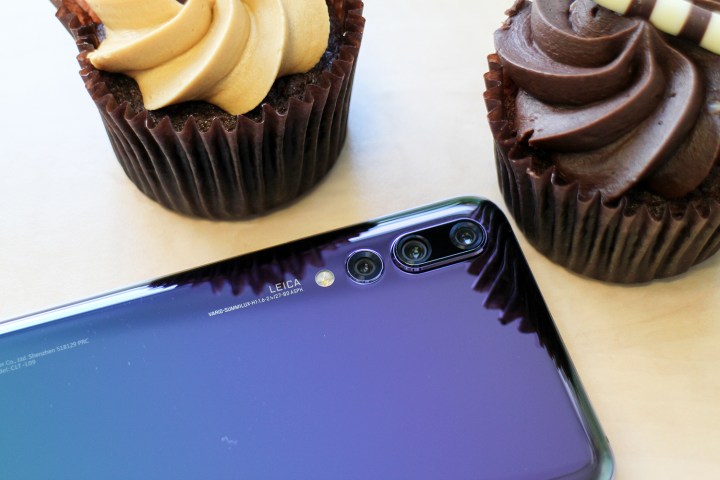The Huawei P20 Pro has been grabbing headlines because of its triple-lens camera, but it has plenty besides that to recommend it. This is a real, cutting-edge 2018 flagship with a price tag to match. But how does it measure up against its predecessor, the Huawei P10 Plus? A lot can happen in a year. Let’s take a closer look and see how these phones compare.
Specs
| Huawei P20 Pro | Huawei P10 Plus | |
| Size | 155 x 73.9 x 7.8 mm (6.1 x 2.9 x 0.3 inches) | 153.5 x 74.2 x 7 mm (6.04 x 2.92 x 0.28 inches) |
| Weight | 174 grams (6.14 ounces) | 165 grams (5.82 ounces) |
| Screen size | 6.1-inch OLED display | 5.5-inch LCD display |
| Screen resolution | 2240 x 1080 pixels (408 pixels-per-inch) | 2560 x 1440 pixels (540 pixels-per-inch) |
| Operating system | Emotion UI 8.1 (over Android 8.1 Oreo) | Emotion UI 5.1 (over Android 7.0 Nougat) |
| Storage space | 128GB | 64GB or 128GB |
| MicroSD card slot | No | Yes |
| Tap-to-pay services | Google Pay | Google Pay |
| Processor | Kirin 970 | Kirin 960 |
| RAM | 6GB | 4GB or 6GB |
| Camera | Triple lens 40MP, 20MP, and 8MP rear, 24MP front | Dual lens 20MP and 12MP, 8MP front |
| Video | 2160p at 30 frames per second, 1080p at 30 fps, 720p at 960 fps | 2160p at 30 frames per second, 1080p at 60 fps |
| Bluetooth version | Bluetooth 4.2 | Bluetooth 4.2 |
| Ports | USB-C | USB-C |
| Fingerprint sensor | Yes | Yes |
| Water resistance | IP67 | IPX3 |
| Battery | 4,000mAh | 3,750mAh |
| App marketplace | Google Play Store | Google Play Store |
| Network support | T-Mobile, AT&T | T-Mobile, AT&T |
| Colors | Black, Blue, Pink Gold, Twilight | White, Blue, Gold, Black, Silver, Rose Gold, Green |
| Price | 899 euros (around $1,100) | 700 euros (around $850) |
| Where to buy it | Huawei, | Huawei, Amazon |
| Review score | Hands-on review | 4 out of 5 stars |
Performance, battery life, and charging

The snappy performance of the P20 Pro is down to Huawei’s own Kirin 970 processor, along with its Neural Processing Unit (NPU), which has a number of special artificial intelligence (A.I.) tricks up its sleeve and is designed to take the burden off the main processor. The P10 Plus has the older Kirin 960 processor and predates Huawei’s push into A.I. There’s no doubt that the P20 Pro will outperform the P10 Plus.
You get 6GB of RAM in the P20 Pro, while the P10 Plus comes in two versions, one with 4GB of RAM and one with 6GB. The P20 Pro offers 128GB of storage, but there’s no MicroSD card slot. The P10 Plus comes with 64GB or 128GB of storage and there is room for a MicroSD card, offering expansion by up to 256GB.
These phones both boast big batteries: The P20 Pro has a 4,000mAh battery, while the battery in the P10 Plus is rated at 3,750mAh. The P20 Pro has a bigger screen, though the resolution is lower, so we’d expect the extra capacity to tell. Sadly, there’s no wireless charging support, but both phones offer Huawei’s SuperCharge fast-charging standard.
Winner: Huawei P20 Pro
Design and durability

These are both expensive-looking, attractive phones, but the P20 Pro looks much more modern than the P10 Plus. Huawei has embraced the notch trend we’re seeing in Android phones and created a gorgeous glass back in various colors. Unusually for a new phone nowadays, the fingerprint sensor is on the front of the P20 Pro, just like it is with the P10 Plus, but the older phone has much larger bezels above and below the screen. On the back, the P10 Plus has that distinctive camera module along the top, whereas the P20 Pro opts for three vertically stacked lenses.
In terms of durability, the P10 Plus has a distinctly disappointing IPX3 rating, while the P20 Pro scores an IP67 rating. In simple terms, this means that the P20 Pro can survive submersion, while the P10 Plus is only equipped to deal with the odd splash.
Winner: Huawei P20 Pro
Display

The P20 Pro boasts a 6.1-inch OLED screen with a 2240 x 1080 pixel screen resolution. The P10 Plus only has a 5.5-inch LCD screen, but it does boast a higher resolution of 2560 x 1440 pixels. In terms of pixel density this means that the P20 Pro scores 408 pixels-per-inch, while the P10 Plus offers 540ppi. The P10 Plus screen is significantly sharper, but the OLED in the P20 Pro has a much higher contrast ratio, with rich colors and really deep blacks. We think the P20 Pro has the superior screen and it’s also much bigger despite the body of the phone not being that much bigger.
Winner: Huawei P20 Pro
Camera
We’re not necessarily convinced that more lenses makes for a better camera, but Huawei clearly is. The P20 Pro has an unprecedented three lenses making up the main camera: There’s a 40-megapixel main lens, an 8-megapixel telephoto lens, and a 20-megapixel monochrome lens. Put that together and you get a very high level of detail, powerful optical zoom, a solid bokeh effect for blurred backgrounds, and great low-light performance.
By contrast, the P10 Plus combines a 12-megapixel primary lens with a 20-megapixel monochromatic lens. We were very impressed with some of the photos we were able to capture with the P10 Plus, but there’s little doubt that the P20 Pro is capable of more — we’re just beginning to test so we can find out how good that triple lens camera really is.
The P10 Plus has a typical 8-megapixel front-facing camera, but the P20 Pro boasts a selfie camera rated at 24-megapixels.
Winner: Huawei P20 Pro
Software and updates

You’ll find the latest Android 8.1 Oreo on the P20 Pro, with Huawei’s EMUI 8.1 user interface on top. The P10 Plus shipped with Android 7.0 Nougat and EMUI 5.1, though it has since been updated to Android 8.0 Oreo and EMUI 8.0. Huawei’s Emotion UI is a real departure from stock Android, but it does offer some nifty tricks. The software experience on these two phones will be very similar, but the P20 Pro has slightly newer software and we expect it to get updates for longer.
Winner: Huawei P20 Pro
Special features

Huawei is firmly focused on the triple-lens camera as the standout feature of the P20 Pro, though the camera was also a headline feature for the P10 Plus. There are no real standout extras that might be described as special features here, but everything you might point to in the P10 Plus, from the software to the battery life, is done better in the P20 Pro.
Winner: Huawei P20 Pro
Price
The P10 Plus has struggled to put up much of a fight here, but it definitely wins on price. The Huawei P20 Pro costs 900 euros (around $1,100), while the P10 Plus costs 700 euros (around $850), though you can get it even cheaper now if you shop around.
We’ve been fans of Huawei’s phones for a while now, so it’s shame the company has run into problems trying to crack the U.S. market. Though you can’t get either of these phones from your carrier, you can still buy them direct from Huawei and use them in the States on T-Mobile or AT&T and they’re widely available in the rest of the world.
Winner: Huawei P10 Plus
Overall winner: Huawei P20 Pro
With a triple-lens camera, a superior processor, a better design, a bigger battery, and greater durability, the P20 Pro is the clear winner here. It looks to be an excellent phone that will surely turn a lot of heads. The only reason you might choose the P10 Plus is to save yourself some money.



